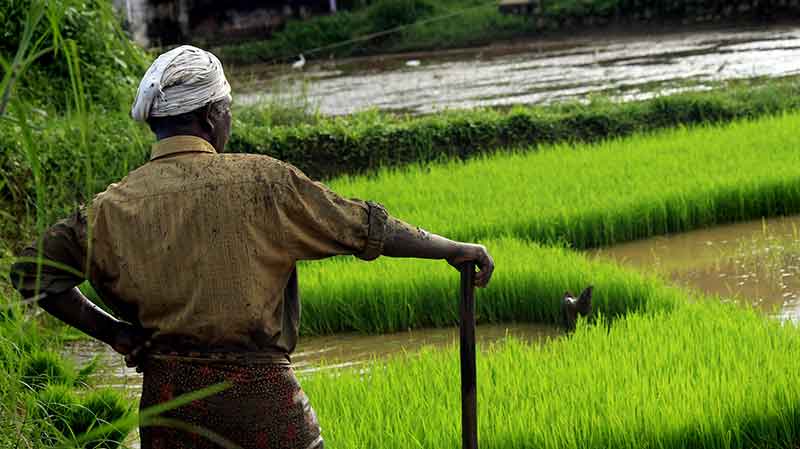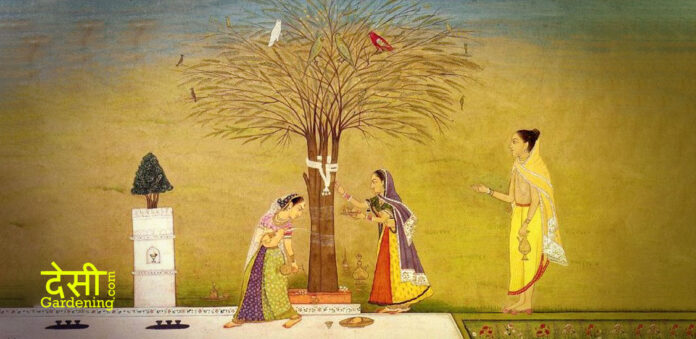Namaskar Desi Gardeners. Today I have brought forth the extremely interesting and amazing topic of Vrikshayurveda.
What is Vrikshayurveda?
Vrikshayurveda is the science of plant, agriculture and flora. Cultivation of crops, holistic gardening, soil and water management, organic fertilization, planting medicinal herbs – all of this has been an integral part of India’s history and heritage. It was an art and a science. There was an in-depth knowledge that was gathered by the sages and researchers of those ages. These farming practices were meticulously followed by the farmers which gave them the best yield.
Vrikshayurveda is based on the principles of the Ayurveda practice that is used for the treatment of the human beings. Therefore, like Ayurveda, it approaches any ‘life’ in a holistic manner. It foundation is the kapha-vata-pitta theory which provides a complete vision.

Vrikshayurveda states that all plants are alive, with soul and emotions and should be approached with love and goodness. Talking to plants gently and classical music makes them feel ‘happy’.
Vrikshayurveda teaches us the importance of how and when to collect plant, roots or its seeds and how to store it correctly. Seed preservation and storage is a crucial expertise, according to the teachers of Vrikshayurveda.
Vrikshayurveda is such a panoramic subject that it will take a lifetime to gain its complete knowledge as a master. Almost every topic in nature has been covered. Bhoomi Varga deals with the classification of various soils, how to enrich, what crops to plant and so on. Krishi Sukti talks about cultivation of soil and care during the crop’s life cycle. It throws light on the pros and cons of organic and inorganic as well in identification of herbs and roots for consumption.
Who wrote about ‘Vrksayurveda’?

Vrikshayurveda was first described in Atharva Veda, the ancient Sanskrit compilation thousands of years old. Later, Vrikshayurveda knowledge was penned in Agnipurana, Arthashastra, Brihat Samhita, Krishi Parasar and Dhanvantari Nighantu, among other ancient books. Today, the most well-known account of ‘Vrksayurveda’ is by ancient Indian scientist Surapala.
Varahamihitra, Surapala, Salihotra, Amarsimha, Kautilya and Rishi Kashyam are some of the great sages and men of wisdom who have spoken about Vrikshayurveda. Viswavallabha is another ancient Sanskrit book of India that talks in details about all aspects of plant science.
Surapala’s ‘Vrksayurveda’ is one of the most detailed compilations on the subject. He has described the plant kingdom as four types – Vanaspati, Druma, Lata, Gulma.
Vanaspati is referred to those fruit plants whose flowers cannot be seen. In Druma plants, both flowers and fruits can be seen. Creepers are called Lata and herbs and shrubs are Gulma.
Does organic pest control really work? The Honest Answer
Some insights from ‘Vrksayurveda’
Land selection

Vrikshayurveda categorizes different types of desa (land) as Sadharan (medium land), Anupa (marshy land) and Jangala (arid land). As the names suggest, the land indicates the geology, ecology and the flora and fauna based on the climate.
However, the classification of the land goes deeper with varna and ras, typically indicating the nutrient value of the soil along with drainage, aeration etc. It classifies 6 varnas or colours of the soil – Asita (black), Pandu (pale), Swetha (white), Shyama (Bluish), Lohita (red) and Peeta (yellow).
Further on, the suitability of crops depends on the land and there it goes into details as to which crops would do well and when.
Plant Diseases

When it comes to plant diseases, it gets more interesting. The physiology of trees and plants is considered very similar to that of human beings. Even in those days, Vrikshayurveda speaks of attacks on plants due to virus, bacteria and different parasites.
Sarira Vyadhi referred to an internal disease in the body whereas Agantuja Vyadhi was a plant injury or discomfort due to an external cause including heat, cold, pests among others.
It explains how to make plants survive any kind of illness as well as external injuries. It speaks of even plastering broken branches and of proper relocation of trees.
Sarira Vyadhis can be caused due to the Vataja (wind), Pittaj (bile) or Kaphaja (phlegmatic). Here is a small check for your plants as to which element is wrong with them.
Vata based diseases
Vata diseases occur when land and air become too dry. Plants and trees can develop crookedness, knots and thinness in trunk, leaves and branches. The fruits borne become less sweet, bitterer and the juiciness is reduced.
Pitta based diseases
Pitta diseases start with overwatering. This types of disease is vey common in late summers, especially when there is less or no rain. The leaves turn yellow and fruits and buds start to drop. Also a decay can be seen in the leaf, flower or fruit.
Kapha based diseases
Can be caused by overwatering among other reasons, diseases of its kind is more common in winter and spring. To identify this, consider if your plant takes too long to bear fruits and flowers. Along with that, leaves can get pale and small. Fruits of such an affected tree will be tasteless.
The efficacy of Vrikshayurveda is undoubtedly peerless. The practitioners of Ayurveda had to have a working knowledge of this science. For example, Vrikshayurveda says that if a medicinal plant gets a disease, its medicinal efficiency is reduced and even lost. Such a plant will not be of any help as a medicine.
Watering guidance for plants and crops
Vrikshayurveda chalks out clearly how and when to water plants as per the seasons.
For newly planted crops and plants, they should watered daily irrespective of season.
For the Hemanta and Shisir seasons (broadly winter), water should be put on alternate days but during the Vasanta Ritu (spring), plants should be watered daily. For the Grishma (summer) plants should be watered in the morning and afternoon (yes, afternoon!). In Sharat Kal (Autumn), if it does not rain for a while, water well around the plants.
Is Vrikshayurveda still in use?
One of the greatest researchers, Acharya Jagadish Chandra Bose, was one of the earliest ‘modern’ scientists in the world to research on Vrikshayurveda. Today, some ancient Sanskrit texts on Vrikshayurveda are being studied by researchers in India. But more than in India, these texts have created an interest in the minds of the western scientists.
Fortunately some of these practices are still being used in India by the farmers in the villages. The knowledge of organic farming in totality had been in use for thousands of years and its knowledge has been transferred from one generation to the other.
Even thousands of years ago, the practitioners of Vrikshayurveda warned against the use of anything inorganic in our plants. Panchagavya was highly recommended for treatment of plant diseases and luckily, it is still easily available in the market.
Scientists and researchers today are barely scratching the surface as they start studying these ancient texts. Hopefully, we will know and start to apply these procedures and one day Vrikshayurveda will replace our outdated chemical-based approach.
Keep an eye on DesiGardening.com, more articles will here soon on Vrikshayurveda!
Fertilizers Used By Gardeners In India
View this post on Instagram
Sources: Vrikshayurveda Presentation by Professor JSR Prasad (https://www.slideshare.net/JSRAPrasad/vkyurveda), https://www.easyayurveda.com/2016/05/11/vriksha-ayurveda-to-improve-plant-health/





























